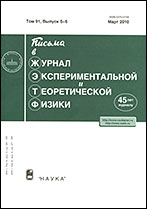|
|
Письма в Журнал экспериментальной и теоретической физики, 2007, том 86, выпуск 10, страницы 713–717
(Mi jetpl912)
|
 |
|
 |
Эта публикация цитируется в 22 научных статьях (всего в 22 статьях)
ПОЛЯ, ЧАСТИЦЫ, ЯДРА
Universal description of the rotational-vibrational spectrum of three particles with zero-range interactions
O. I. Kartavtsev, A. V. Malykh
Joint Institute for Nuclear Research
Аннотация:
A comprehensive universal description of the rotational-vibrational spectrum for two identical particles of mass $m$ and the third particle of mass $m_1$ in the zero-range limit of the interaction between different particles is given for arbitrary values of the mass ratio $m/m_1$ and the total angular momentum $L$. It is found that the number of vibrational states is determined by the functions $L_c(m/m_1)$ and $L_b(m/m_1)$. Explicitly, if the two-body scattering length is positive, the number of states is finite for $L_c(m/m_1)\le L\le L_b(m/m_1)$, zero for $L > L_b(m/m_1)$, and infinite for $L < L_c(m/m_1)$. If the two-body scattering length is negative, the number of states is zero for $L\ge L_c(m/m_1)$ and infinite for $L < L_c(m/m_1)$. For the finite number of vibrational states, all the binding energies are described by the universal function $\varepsilon_{L N}(m/m_1)=\mathcal E(\xi,\eta)$, where $\xi={(N-1/2)}/{\sqrt{L(L+1)}}$, $\eta=\sqrt{m/{m_1 L (L+1)}}$, and $N$ is the vibrational quantum number. This scaling dependence is in agreement with the numerical calculations for $L > 2$ and only slightly deviates from those for $L=1, 2$. The universal description implies that the critical values $L_c(m/m_1)$ and $L_b(m/m_1)$ increase as $0.401\sqrt{m/m_1}$ and $0.563\sqrt{m/m_1}$, respectively, while the number of vibrational states for $L\ge L_c(m/m_1)$ is within the range $N\le N_{\max}\approx1.1\sqrt{L(L+1)}+1/2$.
Поступила в редакцию: 26.09.2007
Образец цитирования:
O. I. Kartavtsev, A. V. Malykh, “Universal description of the rotational-vibrational spectrum of three particles with zero-range interactions”, Письма в ЖЭТФ, 86:10 (2007), 713–717; JETP Letters, 86:10 (2007), 625–629
Образцы ссылок на эту страницу:
https://www.mathnet.ru/rus/jetpl912 https://www.mathnet.ru/rus/jetpl/v86/i10/p713
|


| Статистика просмотров: |
| Страница аннотации: | 230 | | PDF полного текста: | 65 | | Список литературы: | 66 |
|





 Обратная связь:
Обратная связь: Пользовательское соглашение
Пользовательское соглашение
 Регистрация посетителей портала
Регистрация посетителей портала Логотипы
Логотипы








 Цитирование в формате
Цитирование в формате 
